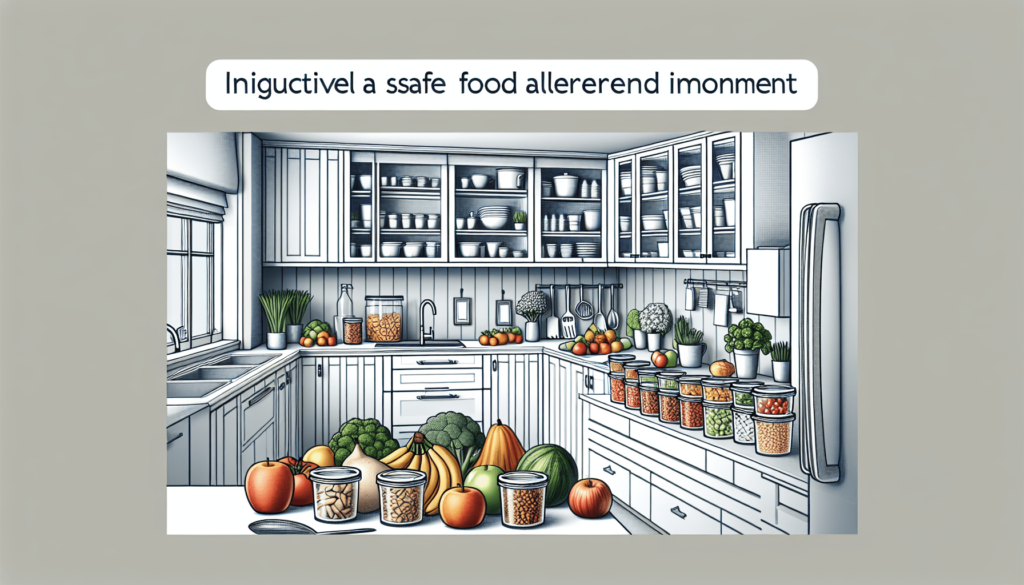Have you been wondering how to create a food allergy-safe home environment? With food allergies becoming more prevalent, it’s crucial to ensure your home is a safe space. This can be particularly vital if a family member or friend has a severe food allergy. Not only does an allergy-safe environment reduce the risk of accidental exposure, but it also offers peace of mind. But where do you start?

Understanding Food Allergies
What Are Food Allergies?
A food allergy occurs when your immune system reacts abnormally to certain foods. Unlike food intolerances, food allergies can trigger severe and sometimes life-threatening symptoms. Common allergens include peanuts, tree nuts, milk, eggs, shellfish, fish, soy, and wheat.
Symptoms of Food Allergies
Recognizing the symptoms of a food allergy is the first step in responding quickly and effectively. Symptoms can range from mild to severe and may include:
- Hives or skin rash
- Swelling of the face, lips, or throat
- Difficulty breathing or wheezing
- Stomach pain, diarrhea, or vomiting
- Anaphylaxis, a severe reaction that requires immediate medical attention
Identifying and Labeling Allergens
Reading Food Labels
One of the most critical skills you will need is reading food labels accurately. The Food Allergen Labeling and Consumer Protection Act (FALCPA) mandates that manufacturers identify common allergens on packaging. Always check labels even on products you trust, as ingredients can change without notice.
Example of Allergen Labeling:
| Allergen | Common Foods |
|---|---|
| Peanuts | Peanut butter, baked goods |
| Tree Nuts | Almonds, cashews, pesto |
| Milk | Cheese, yogurt, ice cream |
| Eggs | Cakes, mayonnaise, pasta |
| Shellfish | Shrimp, crab, lobster |
| Fish | Sushi, fish sauce, worcestershire sauce |
| Soy | Tofu, soy milk, edamame |
| Wheat | Bread, pasta, cereals |
Organizing Your Kitchen
Think about dedicating specific areas of your kitchen to allergen-free foods. Use separate shelves in the pantry and fridge for allergy-free items, and consider labeling them clearly. This organization helps everyone in the household understand what is safe to use and consume.
Preparing and Cooking Meals Safely
Cross-Contamination Prevention
Cross-contamination can happen easily during food preparation. Here are some tips to mitigate that risk:
Separate Utensils
Use different utensils for preparing allergen-free meals. Color-coded cutting boards and utensils can be beneficial to avoid confusion.
Cleaning Thoroughly
Surfaces and utensils should be cleaned thoroughly with hot, soapy water after preparing meals. Dishwashers are excellent for eliminating allergens.
Safe Cooking Practices
Cooking for someone with food allergies requires extra attention to detail:
- Always cook allergen-free foods first.
- Use separate pots, pans, and cooking utensils for allergen-free meals.
- Keep allergen-free foods covered when other foods are being prepared to avoid airborne allergens.
Educating the Household
Training Family Members
Everyone in the household should understand the severity of food allergies and the importance of maintaining an allergy-safe environment. Consider holding a family meeting to discuss:
- The specific allergies involved
- How to read food labels
- Safe cooking practices
- Emergency procedures
Setting House Rules
Establishing house rules can be an effective way to ensure everyone is on the same page. Some suggested rules include:
- No sharing of food or utensils
- Washing hands before and after eating
- Reporting any exposure to allergens immediately

Stocking Allergy-Emergency Supplies
What to Include
Preparation for an emergency is just as important as prevention. Have a designated area where you store allergy-emergency supplies such as:
- Epinephrine auto-injectors (EpiPens)
- Antihistamines
- Medical ID bracelets
- Emergency contact information
Training for Emergencies
Ensure that everyone knows how to use emergency supplies. This includes practicing the use of an epinephrine auto-injector and knowing when to contact emergency services.
Dining and Entertaining with Allergies
Hosting Allergy-Safe Events
When hosting events, it’s essential to notify guests of any present food allergies. Prepare a menu that avoids allergens and label dishes clearly. Additionally, make sure that guests are aware of the severity of specific allergies and the measures in place to prevent exposure.
Dining Out Safely
If you decide to eat out, research the restaurant beforehand to ensure they can accommodate your dietary restrictions. When you arrive, inform the server and chef about the specific allergens to avoid cross-contamination.
Managing Allergies in Children
Schools and Daycare
Communicate with your child’s school or daycare about their food allergies. Provide a detailed action plan, including:
- A list of allergens
- Description of symptoms
- Emergency protocols
- Necessary medications
Educating Your Child
Teaching your child about their allergies is crucial. Ensure they understand:
- What foods to avoid
- The importance of not sharing food
- When and how to seek help if they experience symptoms
Traveling with Food Allergies
Planning Ahead
Traveling when someone has food allergies takes careful planning. Here are some steps to ensure a safe trip:
- Research and prepare a list of restaurants that cater to food allergies.
- Pack allergy-safe snacks and meals.
- Inform airlines, hotels, or cruise staff of your allergies in advance.
Carrying Emergency Supplies
Always bring an ample supply of your emergency allergy medications. Keep them easily accessible, and ensure travel companions know how to use them.
Building a Support Network
Connecting with Others
Building a support network can provide invaluable support. Consider joining local or online allergy support groups to share experiences, tips, and advice.
Educating Extended Family And Friends
It’s equally important to educate extended family and friends about food allergies. The more people understand, the more they can assist in creating a safe environment.
Conclusion
Creating a food allergy-safe home environment doesn’t have to be overwhelming. By following these guidelines and staying vigilant, you can ensure that your home remains a haven for those with food allergies. Regularly update your knowledge, communicate openly, and don’t hesitate to ask for help when you need it. With a little effort and collaboration, everyone can feel confident and secure in your home.
